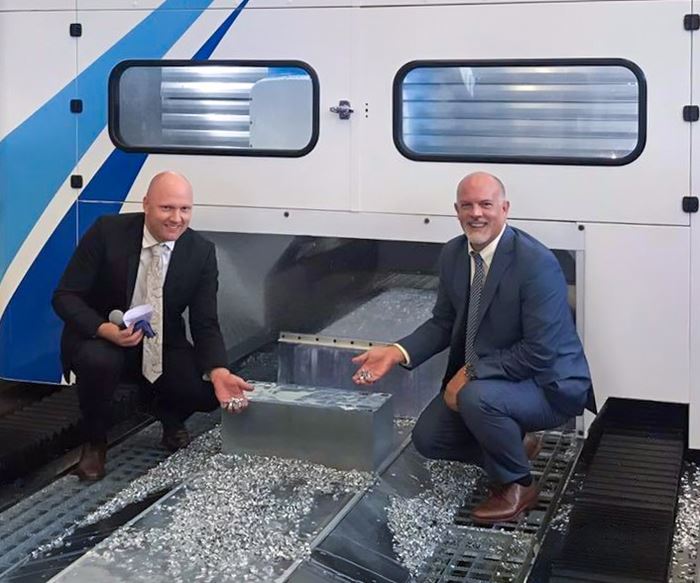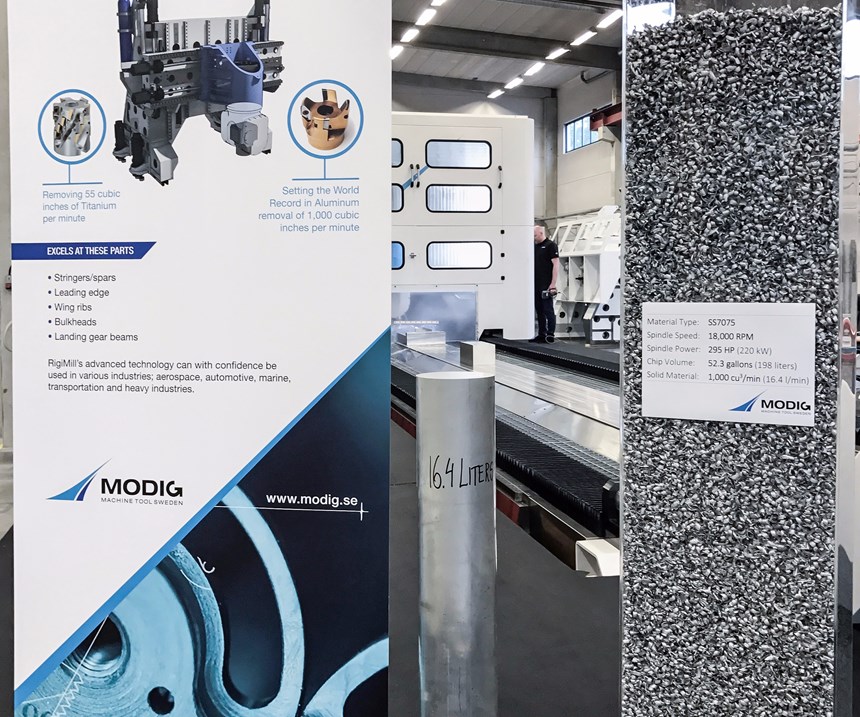Aluminum Material Removal Rate New World Record?
Sweden’s Modig Machine Tool says it has achieved the world’s highest material removal rate in aerospace-grade aluminum at 1,001 cubic inches per minute.
Share








Hwacheon Machinery America, Inc.
Featured Content
View More
Takumi USA
Featured Content
View More.png;maxWidth=45)
DMG MORI - Cincinnati
Featured Content
View MoreSwedish machine tool builder Modig Machine Tool has set what the company claims to be a new world record in material removal rate for aerospace-grade aluminum: 1,001 cubic inches per minute (which relates to a chip volume of 52.3 gallons). The world record attempt took place October 4 during a company open house in Viserum, Sweden.
Founded in 1947, the third-generation company specializes in high-speed machining centers for the aerospace industry. Its five-axis RigiMill machine used in this demonstration is a single-spindle, gantry-type milling machine designed for long-bed machining of aluminum or titanium.
The world record attempt (seen here) had the RigiMill running at 18,000 rpm and 295 horsepower to machine a billet of SS7075 aluminum alloy commonly used for aerospace components. According to Modig, the highest possible material removal rate in this type of aerospace aluminum used to be 850 cubic inches per minute. In Modig’s attempt, a 63-mm, four-flute Alumaster cutter from Seco Tools was chosen for this high-performance machining task. The cutting tool company recommended this type of cutter after testing a range of tools to match Modig’s power and chip-removal requirements. The machine was set to a feed rate of 1,130 ipm and a 0.424-inch depth of cut.
Modig says this machine aims at reduced cost per part for production of large aircraft components. “Time is money,” says Keith Lopez, Modig president—North America, when asked why high metal-removal rates are so important. “Our customers include Boeing, Airbus, Sikorsky, Volvo Aero and many other aerospace companies. If we can reduce the machining time by 40 percent, this equates to increased capacity and reduced cost per part. That makes anyone with this machine more cost competitive while quoting new work, and our customers will definitely see a gain in current work.
“We know, for instance, that we have significantly reduced machining times for wing stringers and chords,” he says. “While it previously took 384 minutes to run a production part, it can now be machined in 74 minutes.”
But the machine doesn’t stop with high-speed aluminum machining. Customers can choose from pre-configured gantries designed for either aluminum or more challenging metals such as titanium. As much as 55 cubic inches per minute material removal rate is achievable in titanium, Mr. Lopez says, adding that the machine is not only capable of high-speed roughing operations, but finishing operations, too. He notes that the machine can achieve surface qualities to 0.8-micron Ra (32-microinch Ra). “Most machines are either very rigid for roughing, which makes them slower, or they are very fast and not strong enough to rough at the best rates,” Mr. Lopez says.
The RigiMill offers virtually unlimited X-axis travel (depending on customer demands), and Y- and Z-axis travels measure 61.4 and 35.4 inches, respectively. The machine can be equipped with a 30,000-rpm spindle and fitted with a maximum 300-tool magazine. Tool-to-tool change time is said to be four seconds; chip-to-chip time is 13 seconds. The rapid traverse rate is 2,800 ipm.
Related Content
-
Ballbar Testing Benefits Low-Volume Manufacturing
Thanks to ballbar testing with a Renishaw QC20-W, the Autodesk Technology Centers now have more confidence in their machine tools.
-
How to Determine the Currently Active Work Offset Number
Determining the currently active work offset number is practical when the program zero point is changing between workpieces in a production run.
-
The Future of High Feed Milling in Modern Manufacturing
Achieve higher metal removal rates and enhanced predictability with ISCAR’s advanced high-feed milling tools — optimized for today’s competitive global market.







































